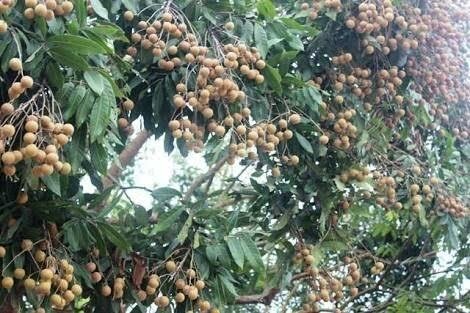Chrysophyllum albidum

|
|
Chrysophyllum albidum Common Names: African Star Apple, White Star Apple
Species ID: NMP-020 | wfo-0000853909 | NCBI:txid1220070 Scientific
Classification Kingdom: Plantae Phylum: Tracheophyta Class: Magnoliopsida Order: Ericales Family: Sapotaceae Genus: Chrysophyllum Species: C. albidum Synonyms: Achras sericea Schumach. & Thonn., Chrysophyllum
henriquesii Engl., Chrysophyllum kayei S.Moore, Chrysophyllum
millenianum Engl., Planchonella albida (G.Don) Baehni Morphological Description Chrysophyllum albidum, commonly known as the African Star Apple, is a tropical
evergreen tree, typically growing 15–37 m tall, with a straight, cylindrical
trunk up to 2 m in diameter. Its key features include: · Bark: Greyish-brown, fissured, exuding white, gummy latex when cut · Leaves: Simple, alternate, elliptic to obovate, 5–15 cm long, 3–7 cm
wide, glossy dark green above, golden-brown beneath due to fine silky hairs · Flowers: Small, greenish-white, 3–5 mm in diameter, in axillary
clusters, with a sweet fragrance · Fruit: Globose to obovoid, 4–6 cm in diameter, with leathery,
orange-yellow skin when ripe, containing sweet, juicy, white to pinkish pulp
and 4–5 glossy brown seeds Distribution and Habitat Chrysophyllum albidum is native to West and Central Africa, including Nigeria,
Ghana, Côte d'Ivoire, Benin, Togo, Cameroon, and Uganda. It thrives in: · Ecosystems: Lowland rainforests, forest-savanna mosaics, and coastal
forests · Climate: Tropical, with annual rainfall of 1,200–3,000 mm and
temperatures of 22–35°C · Soils: Well-drained, fertile, loamy to sandy, with pH 5.5–7.5 · Altitude: Sea level to 800 m In Nigeria, it is abundant
in southern states like Ogun, Lagos, and Enugu, often cultivated in home
gardens or found wild in forests. Its seasonal fruiting Ethnopharmacology Chrysophyllum albidum, commonly known as the African star apple, is a medicinal plant
widely used in West African traditional medicine. Various parts of the plant, especially
the leaves, bark, roots, and fruits, are recognized for their antioxidant,
antimicrobial, anti-inflammatory, antidiabetic, antimalarial, hepatoprotective,
and antianemic properties. Traditionally, the bark and leaves are used to treat
malaria, fever, wounds, skin infections, and diarrhea, while decoctions from
the roots are employed to manage hypertension and blood-related disorders. The
fruit is rich in vitamin C, iron, and fiber, supporting immune health and
digestive function. Phytochemical studies have identified compounds such as
flavonoids, saponins, tannins, alkaloids, and terpenoids, which contribute to
its wide range of therapeutic effects. Although Chrysophyllum albidum has a
strong reputation in folk medicine, further scientific studies are needed to
validate its medicinal benefits and establish proper therapeutic dosages. · Anti-inflammatory and Analgesic Effects: Ethanolic seed cotyledon extracts (100–400 mg/kg) reduced
acetic acid-induced writhing in mice by 60%, validating use for pain and
inflammation in Nigeria. Eleagnine, an alkaloid, inhibits cyclooxygenase-2
(Idowu et al., 2006; Emudainohwo et al., 2015). · Antimicrobial Activity: Methanolic
root bark extracts inhibited Staphylococcus aureus (MIC
32 µg/mL) and Escherichia
coli (MIC 64 µg/mL), validating use
for wound infections, sore throat, and vaginal infections in Nigeria. Aqueous
fruit extracts showed bactericidal effects against Pseudomonas aeruginosa (MIC 128 µg/mL) (George et al., 2018; Cyril et al.,
2023). · Wound Healing: Hexane
seed extracts (5% w/w) accelerated wound closure in rats by 65% within 14 days,
validating use for skin infections in Nigeria. The latex enhances collagen
synthesis (Oladeji et al., 2016). · Antioxidant
Activity: Chrysophyllum albidum fruit pulp
and seed extracts exhibit significant antioxidant properties. A study
demonstrated that fruit pulp powder at 200 mg/kg body weight significantly
reduced oxidative stress in type 2 diabetic rats by upregulating antioxidant
genes (e.g., SOD and CAT) by 2.5-fold and downregulating pro-inflammatory genes
(e.g., IL-6 and TNF-α) by 40%, suggesting its potential in managing
diabetes-related oxidative damage (Oyetayo et al., 2021). · Antimicrobial
Activity: Leaf extracts of C. albidum have
shown antibacterial effects against gastrointestinal pathogens such as
Salmonella typhimurium, Shigella dysenteriae, Vibrio cholerae, Escherichia
coli, and Clostridium perfringens, with minimum inhibitory concentrations
(MICs) ranging from 6.25 to 25 mg/mL, supporting its use in treating
gastrointestinal infections (Hassan et al., 2019). · Antiplasmodial
Activity: Both the seed and pulp extracts of
C. albidum demonstrated significant antiplasmodial effects in vivo. At doses of
500 and 1000 mg/kg, the seed extract suppressed early Plasmodium berghei
infection by up to 97.3% on day 4 post-infection, comparable to artesunate’s
98.5% suppression, indicating its potential as an antimalarial agent
(Ihekwereme et al., 2017). · Antidiabetic
and Hypolipidemic Effects: The
infusion of C. albidum promotes glucose uptake and utilization, with studies
showing a 30% reduction in blood glucose levels in diabetic rats after 14 days
of treatment with fruit pulp extract at 200 mg/kg. It also reduced serum
triglycerides by 25%, suggesting its role in modulating metabolic activities
linked to type 2 diabetes and hyperlipidemia (Ihekwereme et al., 2017). · Reproductive
Effects: Methanol extract of C. albidum
fruit at 400 mg/kg adversely affected reproductive functions in male Wistar rats, reducing testosterone levels by 35% and
causing testicular architectural anomalies, including seminiferous tubule
degeneration, after 28 days of administration (Ogunwole & Mangai, 2019). ⚠ Toxicity Profile: Oral administration of aqueous C. albidum leaf
extract up to 5000 mg/kg in rats showed no mortality or adverse behavioral
effects, indicating a high safety margin for oral use (Ene et al., 2022).
However, intraperitoneal administration resulted in an LD50 of approximately
1265 mg/kg, with signs of toxicity including lethargy and respiratory distress
at doses above 1000 mg/kg, suggesting potential toxicity at high doses via this
route (Ene et al., 2022). Additional Uses · Culinary: The sweet-tart fruit pulp is eaten fresh, juiced, or used in
desserts and jams in Nigeria and Ghana. · Economic Value: Fruits are sold in local markets across
West Africa, providing income for farmers, particularly during the dry season
(December–April). · Timber and Industrial: The hard, durable wood is used for
furniture and construction; the latex is explored for polyisoprene production. · Cultural Significance: In Yoruba traditions, fruit pulp is used
in rituals for fertility; leaves are used for spiritual cleansing. · Ecological Role: The tree supports biodiversity by
attracting pollinators like bees and seed dispersers like birds in Nigeria. References
More Pictures |
|
| Compounds of Chrysophyllum albidum |
|
| References |